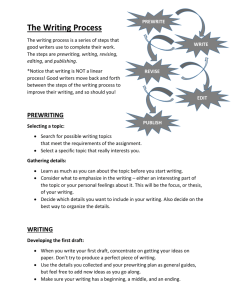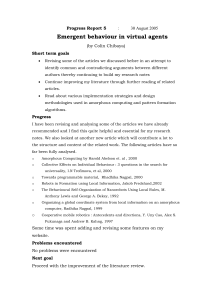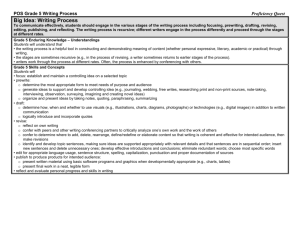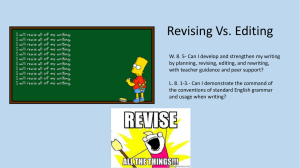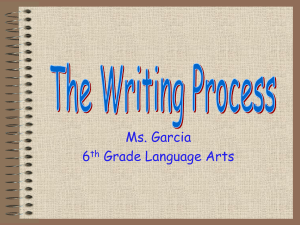Announcements
advertisement
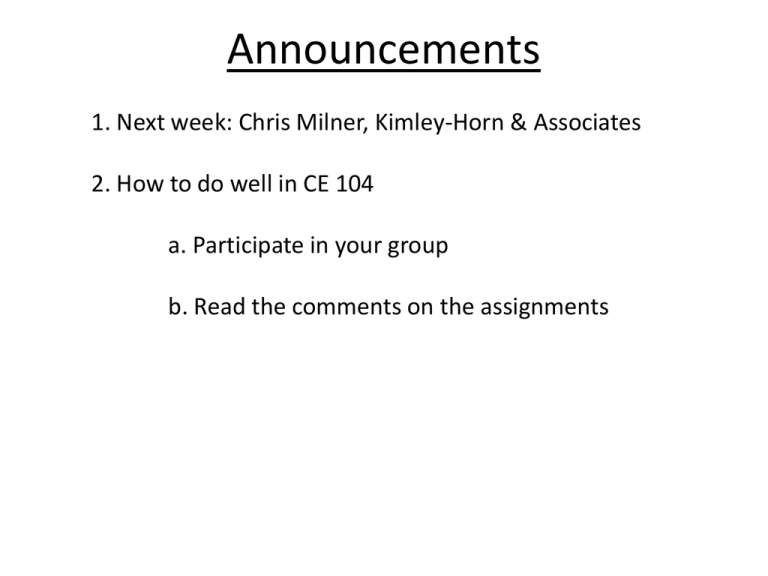
Announcements 1. Next week: Chris Milner, Kimley-Horn & Associates 2. How to do well in CE 104 a. Participate in your group b. Read the comments on the assignments Technical writing! Objective Convey information as quickly, clearly, concisely, and correctly as possible. Powers of the Management Committee: To employ staff, agents and other people (either casually, temporarily, permanently or on secondment) to carry out the objects of the Association upon such terms and conditions as they may from time to time consider desirable, and to terminate such employment or agency, and to pay their salaries, fees, commissions, remuneration and other charges out of the Association's Fund and to confer upon any staff or agents so appointed the right to exercise any discretion which may be vested in the Management Committee Members. The Management Committee may employ staff. Objective Convey information as quickly, clearly, concisely, and correctly as possible. To: A. Customer From: E. L. Ittrett Re: Bridje design Pursuant to your request, of February 6, 2008, please find inclosed the Design of a bridje. Motivation A high school student seeks an internship with Civil Solutions Inc., which is managed by vice president Richard Rehmann. The student walks into the office of Civil Solutions and says, “Where’s Rich?” Could the student have improved his communication? How? Rhetorical factors The student did not consider the factors important in communication: 1. Purpose What do you want? 2. Audience What information does the reader need? 3. Context What is the history? The future? 4. Content Is the content appropriate? Accurate? Purpose What are some possible purposes? Give examples of each. • To inform: Technical report, journal article • To record: Minutes of a meeting, technical report • To persuade: Proposal, review article, essay, brochure • To recommend: Feasibility study, report Audience What are some considerations regarding audience? • • • • • • • • • Who is the likely audience? Do you know the readers? How well? What does the reader already know? What does the reader need to know? What does the reader want to know? What will the reader be able to understand? How much time will the reader have? How will the reader use this information? What questions will the reader most likely have after reading? Context Considerations regarding context: • • • • • • • • • • Need for the document Possible results from the document Budget Timeline Familiarity with audience Audience expectations Health of the relationship with the audience Nature of the subject matter, potential controversy Range of purposes of the readers Audience preferences for verbal or visual descriptions Content Is the content appropriate? Did you • • • • motivate the document sufficiently? provide just enough background? explain what you will do? provide good visuals? Is the content accurate? Did you • • • • check calculations? cite authoritative sources? separate observation from speculation? avoid unwarranted claims? Example: speaker report Write a report of no more than one page (12 point font, single spaced) on the speaker’s presentation. Answer the following questions: 1. What is the speaker’s background? Describe the speaker’s career path briefly. 2. What sort of projects or positions did the speaker describe? 3. What obstacles, barriers, or professional issues arose in the speaker’s career? In particular, discuss how the speaker addressed communication skills, ethics, and leadership in his or her career. 4. What were the key lessons you learned from the talk? Speaker report: rhetorical factors 1. Purpose What is your purpose? Speaker report: rhetorical factors 2. Audience What do we know about the audience? Speaker report: rhetorical factors 3. Context • Need: • Possible results: • Budget: • Timeline: • Familiarity: • Expectations: • Relationship health: • Controversy: • Verbal/visual: Speaker report: rhetorical factors 4. Content Next steps • Generating ideas • Gathering information • Narrowing the information • Outlining Generating ideas How might you generate ideas? “What people somehow (inadvertently, I’m sure) forgot to mention…was that we need to make messes in order to find out who we are and why we are here—and, by extension, what we’re supposed to be writing.” (Anne Lamott, Bird by Bird) Gathering & narrowing information How might you gather information? How might you narrow the information? Outlining 1. Write an outline (or at least a list). 2. Start with a standard template and modify. 3. Add as much detail as you comfortably can. 4. Don’t etch it in stone. Scientific proposal template 1. Significance and objectives a. b. c. d. Significance and motivation Objectives Hypotheses Summary of proposed work 2. Background a. Introduction b. Literature review c. Summary 3. Proposed work a. b. c. d. Overview Details Plan Preliminary work Technical report template • Abstract • Introduction – Problem statement – Background – Overview • • • • • • Methods Results Discussion Conclusions References Appendices Writing the document Are you a farmer or a hunter? Advice: Just start somewhere and write. Make a mess. Break the rules. Writing the document Why is it OK to break the rules and make a mess when you write? Because you are going to revise, revise, revise. “It is no sign of weakness or defeat that your manuscript ends up in need of major surgery. This is a common occurrence in all writing, and among the best writers.” Revising the document Use a top-down approach: 1. Structure 2. Paragraphs 3. Sentences and words a. Sentences b. Grammar c. Word choice d. Punctuation http://www.ucalgary.ca/uofc/eduweb/grammar/marking/ Revising the document 1. Structure Revisit purpose, audience, context, content a. b. c. d. e. f. Did you meet your purpose? Do you have a new purpose? Did you address the audience properly? Did you provide the right content? Do you need more? Can you cut anything extraneous? Revising the document 2. Paragraphs a. Make the paragraph the unit of composition. b. Ask whether you developed the idea sufficiently. < 100 words: Developed enough? > 200 words: Split into two? Revising the document 3a. Sentences Sentence errors are legion: 1. 2. 3. 4. 5. 6. 7. 8. 9. 10. 11. 12. 13. Sentence fragment Run-on sentence and comma splice Fused sentences Overloaded sentence Mixed construction Faulty parallelism Dangling modifier Misplaced sentence elements Shift of number or person Shift of tense, mood or voice Omissions Lack of variety Illogical sentence (e.g., faulty co-ordination, faulty subordination) Revising the document Sentence fragments “If you write a fragment, you fail.” (W. Heston, 1984) Propane and natural gas on the other hand are still fossil fuels, but they hold the potential for a very good short term solution. Short term meaning eventually fossil fuels will be completely depleted. Where’s the fragment? How would you revise? Revising the document Run-ons and fused sentences I also have us booked at Fareway on Friday from 4-8 pm the store manager said the store is busier on Friday than Saturday. How would you revise? I also have us booked at Fareway on Friday from 4-8 pm. The store manager said the store is busier on Friday than Saturday. Revising the document Mixed construction Convective heat transfer is when the flow carries the heat. In convective heat transfer the flow carries the heat. The reason the coverage of the Olympics frustrates him is because NBC focuses on the stories instead of the sports. NBC’s coverage of the Olympics frustrates him because it focuses on the stories instead of the sports. Temperatures in Ames will be warmer this weekend. Temperatures in Ames will be higher this weekend. Ames will be warmer this weekend. Revising the document Faulty parallelism Sugarbush Ski Instruction ● Exciting ● Lots of experience ● Enjoyable ● You’ll have a great time! Revising the document Faulty parallelism Elements of a list must have the same grammatical form. Compare apples to apples. The experiments will involve measuring velocity, sampling the water quality, and to record the wind speed. How would you revise? The experiments will involve measuring velocity, sampling the water quality, and recording the wind speed. Revising the document Misplaced modifier What is wrong with these sentences? Nailed to the fence, Julie read the sign. Having eaten the remains of the zebra, we watched the lion lick its chops. Revising the document Dangling modifier What is wrong with these sentences? Groundwater contamination is a major concern when designing the geologic repository. Varying from a simple lime softening system to a complex electrodialysis reversal operation, the incidence of radium in drinking water can be greatly reduced. Based on these tests, we conclude that this option is not feasible. How would you revise them? Revising the document 3b. Grammar 1. 2. 3. 4. 5. 6. 7. 8. Idiomatic grammatical constructions Syntax Usage Case Verb form References Subject-verb agreement Parts of speech Revising the document General pronoun reference Antecedents of pronouns need to be unambiguous. These conditions allow MTBE to travel quickly and with little hindrance into the groundwater. This poses a huge problem because the plume for MTBE is much longer than that for any other gasoline product. What is “This” in this passage? Revising the document Subject-verb agreement What is wrong with this sentence? Revising the document 3c. Word choice 1. 2. 3. 4. 5. Wrong word Too many words Excessive compression Diction Active/passive voice Revising the document Wrong word Correct the errors in these messages: Your ignorant of the ways of the world. This is a reminder email that I send to all the authors. If you have all ready uploaded all your papers and have received confirmation emails than your okay. Revising the document Too many words 15% of words in technical writing are unnecessary. Unnecessary Necessary Source: Rehmann made this up. Revising the document Too many words Shorten these sentences: At this point in time, the firetrucks have not arrived at the airport. The firetrucks have not arrived at the airport. In order to give an estimate of the dissipation, we made measurements of the velocity with PIV, which is capable of achieving small-scale resolution. To estimate the dissipation, we measured the velocity with PIV, which can resolve small scales. Revising the document Too many words Shorten these sentences: He utilized a saw to facilitate the cutting of the wood. He cut the wood with a saw. Upon visual inspection, there are three discernible regimes. There are three regimes. Revising the document Too many words Put action in verbs, not nouns. Clue: look for “of”. In all cases the variable dispersion coefficient model provided a much more accurate description of experimental results. The variable dispersion coefficient describes the experimental results more accurately. Electrodialysis reversal (EDR) uses electric current to achieve removal of hardness and other ions. Electrodialysis reversal (EDR) uses electric current to remove hardness and other ions. Revising the document Too many words Just say it: I am in a position to complete a purchase of a new car. Due to the fact that he experienced a sudden illness, it was necessary that the trip be cancelled. You should have a discussion with Prof. Rehmann if you are in a situation in which you have questions concerning the matter of dimensional analysis. Revising the document Too many words Don’t oversay it. past memories various differences each individual basic fundamentals true facts important essentials future plans terrible tragedy end result final outcome free gift past history unexpected surprise sudden crisis very unique large in size often times of a bright color heavy in weight period in time round in shape at an early time economics field of cheap quality honest in character of an uncertain condition in a confused state unusual in nature extreme in degree of a strange type Revising the document Too few words: excessive compression Omit needless words, but don’t overdo it. An efficient anti-aliasing spectral continuous window shifting technique for PIV (article title) Revising the document Diction Avoid slang: This report will take an in-depth look at the Yucca Mountain Project. Avoid cliches: These experiments go hand-in-hand with the numerical simulations. Don’t inflate your language: The skier’s speed is dependent on many factors. Revising the document Diction Don’t mix metaphors: He is not the sharpest cookie in the jar. You can beat a dead horse to water, but you can't make him drink. That's the pot calling the kettle's bluff. He's got too many oars in the fire. It's not rocket surgery. I can see the carrot at the end of the tunnel. The monkey is in your court. Not to put her up on a limestone, but my sister is really terrific. We are treading on thin water We'll burn those bridges when we get to them. Revising the document Active/passive voice Prefer the active voice: The effect of flow length on longitudinal dispersivity was studied by Xu and Eckstein (1995), and it was found that the dispersivity increases with length. Xu and Eckstein (1995) studied the effect of flow length on longitudinal dispersivity and found that the dispersivity increases with length. The longitudinal dispersivity increases with flow length (Xu and Eckstein 1995). Revising the document 3d. Punctuation Separate independent clauses with a comma before the conjunction (and, but, or,…). We went to the store and bought milk. We went to the store, and then Gunnar called. Revising the document Use a comma or commas to set off a non-restrictive (i.e., non-essential information) phrase or clause… Richard, my brother, did not hire that high school student. I drove my Subaru, which is green. …but if the phrase or clause is restrictive, do not use commas. I drove my car that I bought in Hyannis, Massachusetts. Revising the document Use commas to separate items in a list: I bought eggs, milk, and bread. The comma before the conjunction is optional, but it helps avoid confusion: I thank my parents, Hillary Clinton and Mitt Romney.
